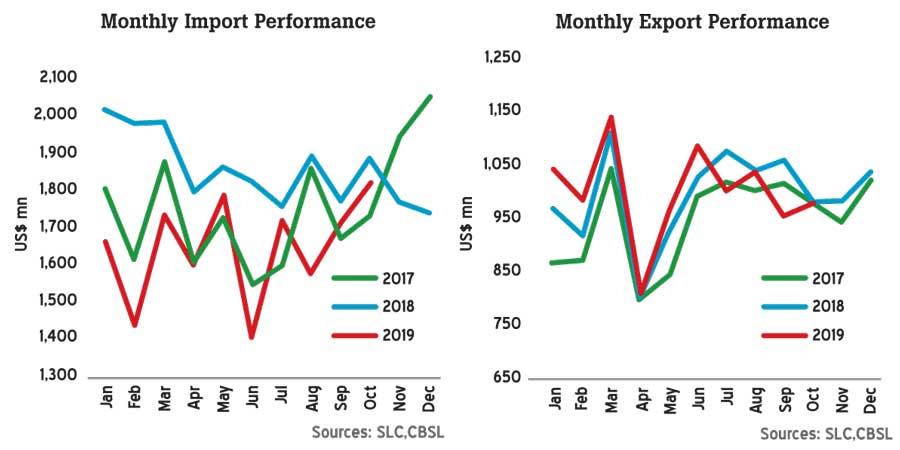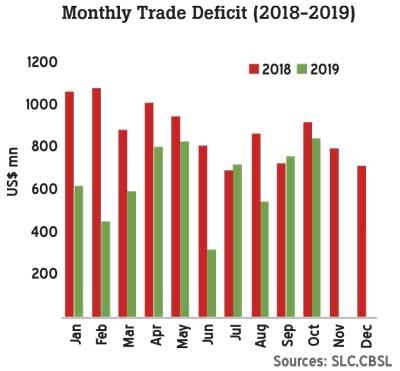16 Dec 2019 - {{hitsCtrl.values.hits}}

Sri Lanka’s trade deficit contracted in the month of October and also during the first 10 months of 2019 amid slight gain in export income and considerable decline in import expenditure, according to the external trade data released by the Central Bank.
October 2019 trade deficit narrowed to US$ 838 million from US$ 903 million a year ago while the cumulative trade gap contracted to US$ 6, 451 million from US$ 8,857 million.

Cumulative exports during the January-October 2019 period edged up 0.8 percent year-on-year (YoY) to US$ 9, 960 million while imports fell 12.4 percent YoY to US$ 16, 412 million amid lower personal vehicle imports and lower import expenditure on fuel due to lower international prices.
However, in the month of October, merchandise exports fell marginally by 0.2 percent YoY to US$ 977 million as agricultural exports fell 3.3 percent YoY to US$ 4 210.2 million as tea, rubber, coconut and spice exports fell barring minor agricultural products which rose 38.7 percent YoY to US$ 12.1 million.
Industrial exports led by textiles and garments edged up by 0.6 percent YoY to US$ 762.1 million as textile and garments exports rose 3.5 percent YoY to US$ 407.9 million. Such imports during January-October rose 6.3 percent YoY to US$ 4, 628.4 million.
Rubber products exports, which mainly consist of tyres, fell 1.6 percent YoY to US$ 70.3 million.
Petroleum products exports carried out to facilitate bunkering services fell 29.1 percent YoY to US$ 41.5 million due to lower bunker prices.
Export of printing industry products surged over 258 percent YoY to US$ 5.4 million in October while gems, diamonds and jewellery exports rose 23.5 percent YoY to US$ 30 million.
Meanwhile, October imports expenditure fell 3.5 percent YoY to US$ 1,815 million amid lower consumer goods imports helped by lower personal vehicle imports, which fell 47.4 percent YoY to US$ 84.6 million.
Vehicle imports during January-October 2019 fell 53.2 percent YoY to US$ 651 million.
“However, motor vehicle imports remained at a relatively high level, on average since July 2019 compared to values recorded during the first half of 2019, mainly reflecting the impact of the resumption of personal motor vehicle imports under concessionary permits,” the Central Bank said.
Sri Lanka’s fuel bill, which includes crude oil, refined petroleum and coal rose 15.9 percent YoY in October 2019 to US$ 308.3 million amid higher crude oil imports.
The import of textiles and textile articles fell 0.9 percent YoY to US$ 277.1 million. Wheat and maize imports also fell 38.8 percent YoY to US$ 33 million.
Import expenditure on investment goods fell 8.2 percent YoY to US$ 391 million as all three major sub-categories—machinery and equipment, building material and transport equipment recorded declines.
Amid other major inflows to the Current Account, tourism earnings for the month of October were estimated at US$ 233 million in comparison to US$ 287 million a year ago.
In cumulative terms, earnings from tourism were estimated at US$ 2, 806 million during the first 10 months of 2019 compared to US$ 3, 538 million during the corresponding period of 2018. Workers’ remittances grew by 1.3 percent YoY to US$ 607 million in October 2019. However, the cumulative figure for the 10 months fell 5.8 percent YoY to US$ 5, 537 million.
Meanwhile foreign investment in rupee denominated government securities recorded a net inflow of US$ 12 million in October 2019. But on a cumulative basis, net outflows from the government securities market amounted to US$ 280 million during the first 10 months of 2019.
Foreign investment in the Colombo Stock Exchange, including primary and secondary market transactions, recorded a net outflow of US$ 10 million during October. Nevertheless, financial inflows to the CSE recorded a marginal net inflow of US$ 5 million during the first 10 months of 2019.
15 Nov 2024 3 hours ago
15 Nov 2024 5 hours ago
15 Nov 2024 5 hours ago
15 Nov 2024 6 hours ago
15 Nov 2024 6 hours ago